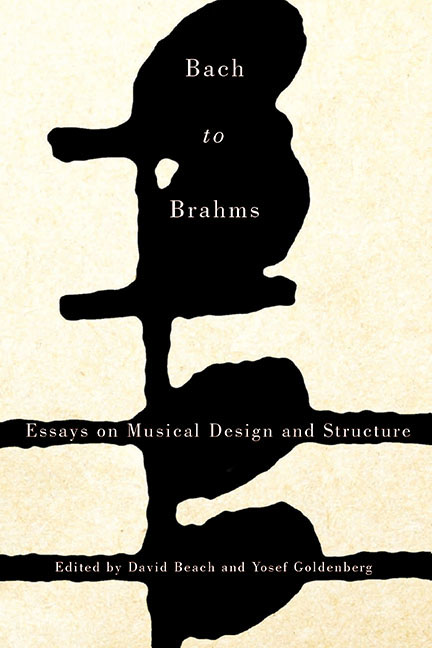Book contents
- Frontmatter
- Dedication
- Contents
- Introduction
- Part One Structure and Design
- Part Two Focus on Motive
- Part Three Structure and Design II
- 11 The “Pseudo-Einsatz” in Two Handel Fugues: Heinrich Schenker's Analytical Work with Reinhard Oppel
- 12 Formal Fusion and Its Effect on Voice-Leading Structure: The First Movement of Beethoven's Opus 132 Revisited
- 13 Indistinct Formal Functions and Conflicting Temporal Processes in the Second Movement of Brahms's Third Symphony
- 14 The Interaction of Structure and Design in the Opening Movements of Schubert's Piano Trios in B-flat Major (D. 898) and E-flat Major (D. 929)
- 15 The Suspenseful Structure of Brahms's C-Major Capriccio, Op. 76, No. 8: A Schenkerian Hearing
- List of Contributors
- Index
14 - The Interaction of Structure and Design in the Opening Movements of Schubert's Piano Trios in B-flat Major (D. 898) and E-flat Major (D. 929)
from Part Three - Structure and Design II
Published online by Cambridge University Press: 14 March 2018
- Frontmatter
- Dedication
- Contents
- Introduction
- Part One Structure and Design
- Part Two Focus on Motive
- Part Three Structure and Design II
- 11 The “Pseudo-Einsatz” in Two Handel Fugues: Heinrich Schenker's Analytical Work with Reinhard Oppel
- 12 Formal Fusion and Its Effect on Voice-Leading Structure: The First Movement of Beethoven's Opus 132 Revisited
- 13 Indistinct Formal Functions and Conflicting Temporal Processes in the Second Movement of Brahms's Third Symphony
- 14 The Interaction of Structure and Design in the Opening Movements of Schubert's Piano Trios in B-flat Major (D. 898) and E-flat Major (D. 929)
- 15 The Suspenseful Structure of Brahms's C-Major Capriccio, Op. 76, No. 8: A Schenkerian Hearing
- List of Contributors
- Index
Summary
The focus of this study is the interaction—more specifically the disjunction— of structure and design in the first movements of Schubert's Piano Trios in B-flat Major (D. 898) and E-flat Major (D. 929). The term “structure” is used here to mean voice leading at multiple levels as defined by Heinrich Schenker in Free Composition, and “design” refers to formal organization, the division of a musical work into larger and smaller units. Associated with formal design are key and key succession. While it is extremely important that we distinguish clearly between the two aspects of a composition's organization (its formal/ tonal design and its voice-leading structure), it is equally important to realize that a complete understanding of a musical work depends on the thorough investigation of both, as well as other relevant aspects of a work's design. Most often the two are in agreement, but when they are not, this is not only signifi- cant but also requiring of interpretation.
Before examining the two movements that are the focus of this study, it is first helpful to consider two characteristics of Schubert's treatment of sonata form, both of which create a disjunction between formal design and underlying structure. The first of these is the three-theme and three-key exposition that we find in some of Schubert's works. Consider, for example, the exposition of the first movement from the C-Major Quintet (D. 956), which has three distinct themes in the keys of C, E-flat and G major. From the perspective of the formal design, the three share equal status, but from the perspective of underlying structure, the function of the second key and the theme it supports is secondary to the motion from tonic to dominant; that is, they serve to prolong the tonic on the path to V and interruption of the fundamental line.
The second characteristic of Schubert's treatment of sonata form is his proclivity for stating the thematic recapitulation in a key other than the tonic. Many of these movements share a common procedure, namely reproducing the key scheme of the exposition in the recapitulation, such that it ends (not begins) on the tonic.
- Type
- Chapter
- Information
- Bach to BrahmsEssays on Musical Design and Structure, pp. 239 - 258Publisher: Boydell & BrewerPrint publication year: 2015



